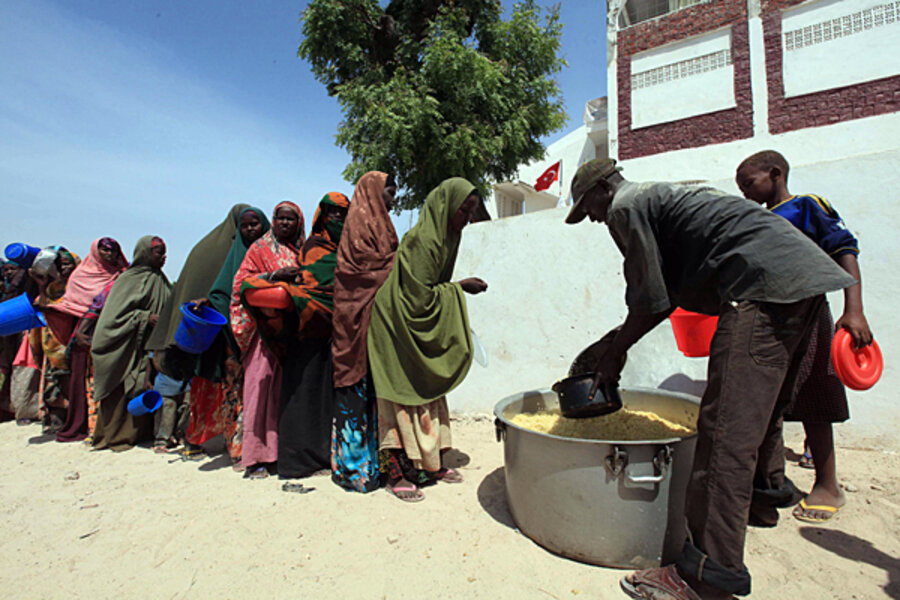Famine ends in Somalia, as drought looms in West Africa
Loading...
Somalia’s seven-month-long famine – which killed tens of thousands and forced nearly 4 million people dependent on food aid for survival – has finally come to an end, according to the United Nations.
In a study of weather patterns, improved local harvests, and availability of food aid, the UN Humanitarian Coordinator for Somalia Mark Bowden told reporters today that “famine conditions are no longer present.”
The victory is a fragile one, however, as an internationalized war in Somalia rages across the southern part of the country. Drought conditions, too, could return in May with Somalia’s dry season. Some 2.3 million people in Somalia and nearly 10 million people throughout the Horn of Africa still depend on food aid for survival. Still, the turnaround is seen as evidence by aid agencies that emergency humanitarian aid can make a difference.
“125,000 children no longer face severe malnutrition – thanks largely to the efforts of the Somalis themselves and the humanitarian aid they’ve received. That can only be excellent news, but we must not be complacent,” said Senait Gebregzhiabher, the head of Oxfam in Somalia, in an e-mailed statement.
These gains can be reversed, Mr. Gebregzhiabher added. "We are seriously concerned that if people do not have the security to tend their crops and animals, or the freedom to access clean water and food in the markets, the humanitarian situation will deteriorate once again.
At its height, the drought in the Horn of Africa region affected 12 million people, in Somalia, Ethiopia, and in northern Kenya. Early warnings from a Famine Early Warning System (FEWS) – a complex system of field censors and satellite data – alerted donor agencies well in advance, but a slow response of donor nations in 2011 may have cost the lives of 29,000 children under the age of 5, according to studies by the US government.
Donor nations came under heavy criticism for their slow response, but aid groups acknowledge the situation is exacerbated by Somalia’s security situation, where Islamist rebel groups have restricted the activities of major aid organizations. Just this week, the radical Al-Shabab militia banned the International Committee of the Red Cross from operating in the areas of southern central Somali that remain under Al-Shabab control.
On Twitter, an Al-Shabab spokesman calling himself (or herself) @HSMPress accused the Red Cross of distributing outdated food that was “unfit for human consumption.”
What about drought?
But as famine eases in East Africa, there are signs that a severe drought is beginning to take hold in West Africa, placing strains on a global aid system that is still struggling to recover from the Horn of Africa drought of 2011.
On Thursday, the UN Special Rapporteur on the Right to Food, Olivier De Schutter, told reporters in Accra, Ghana that an ongoing drought in Chad, Mali, Mauritania, and Niger is showing signs of spreading to Burkina Faso, Senegal, and northern parts of Nigeria and Cameroon.
Grain supplies are already 50 percent lower than required in Chad and Mauritania. Declining supplies have made the food that is available more expensive. In Niger, the price of millet went up 37 percent last November, compared with the same period in 2010.
"The [drought] season will come earlier and last longer than usual. This will leave the Sahel hugely reliant on food imports, which will have to be acquired at sky-high prices on the international market,” Agence France Presse news agency quoted Mr. De Schutter as saying. “We must not wait until people are starving in order to act. The world must respond immediately to avert a full-scale food and nutrition crisis.”
What next?
A coalition of emergency aid groups, including Oxfam and Save the Children, has called for long-term solutions to drought relief, including the creation of a global aid fund that can be dipped into in times of emergency.
Kofi Annan, the former UN Secretary General has called food security “the challenge of our time.”
“Our success in alleviating widespread hunger," Mr. Annan said in a recent statement, "will depend, in large part, on our ability to identify the early warning signs of food crises, and respond immediately and effectively.”







